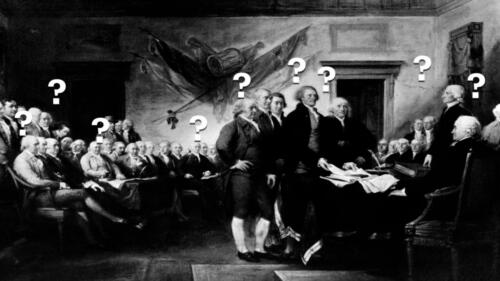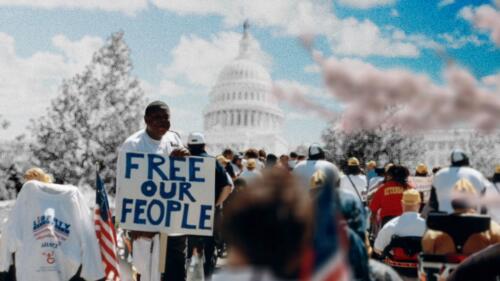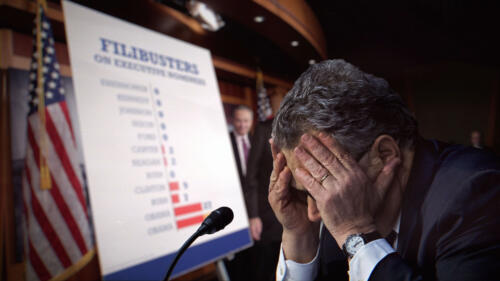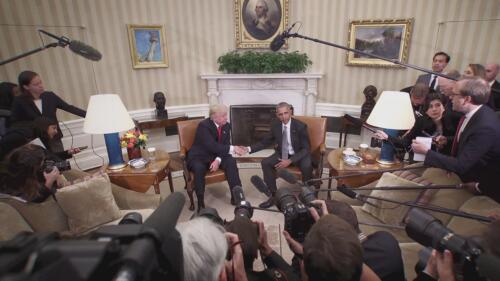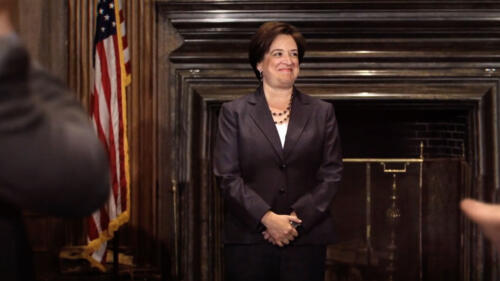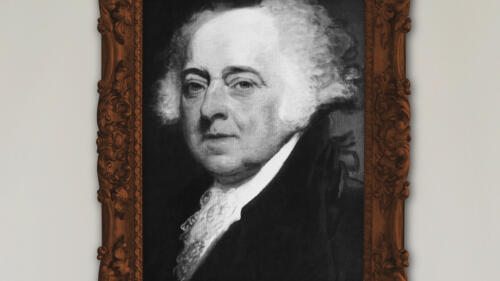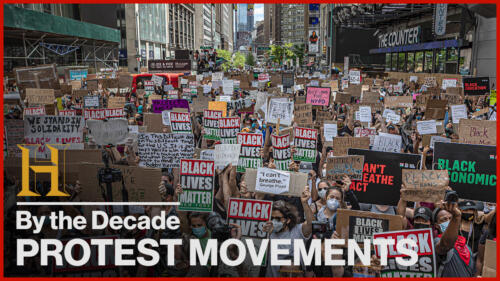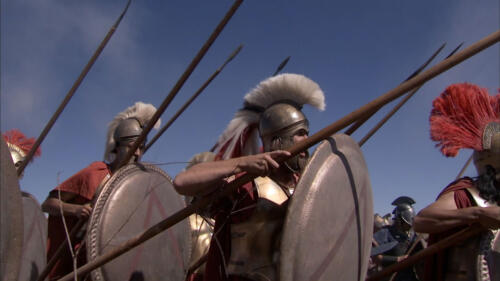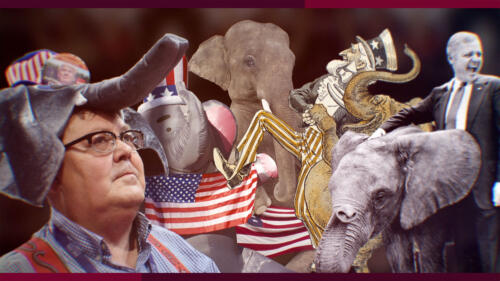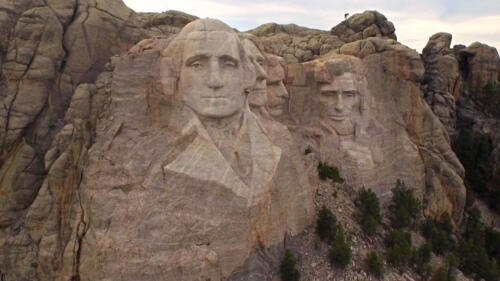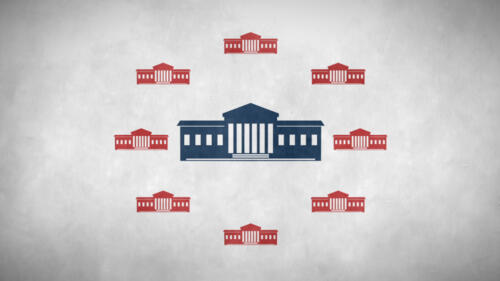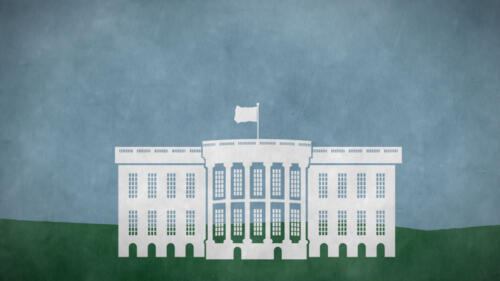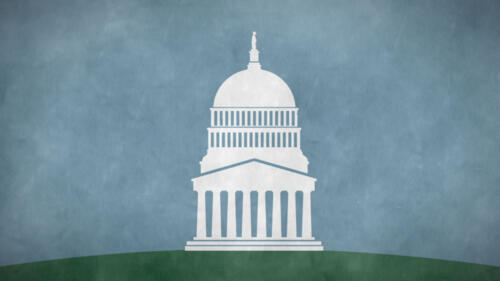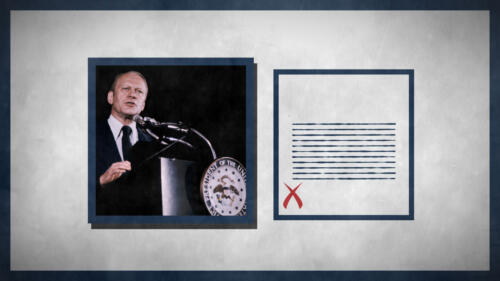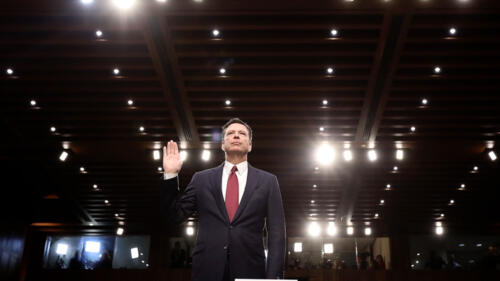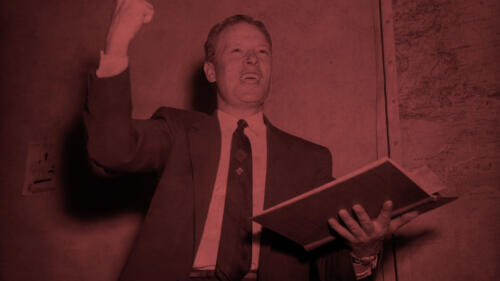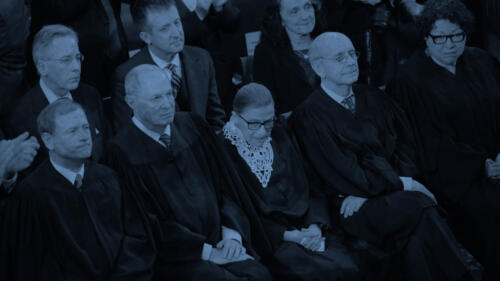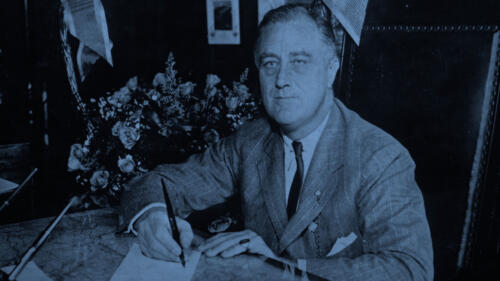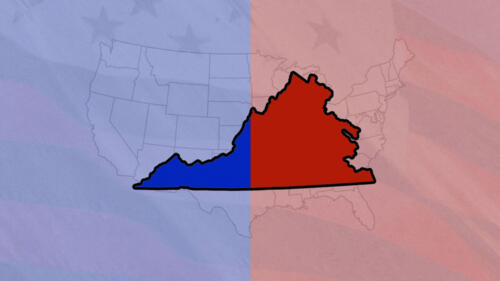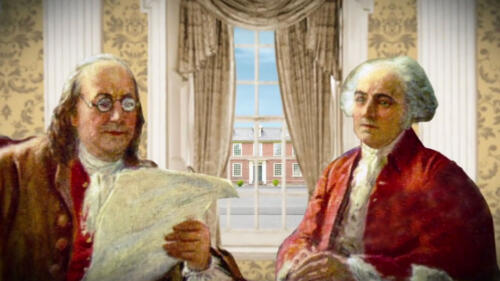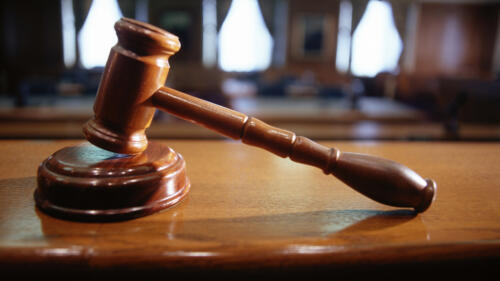U.S. Government and Politics
The U.S. government, with its three distinct branches and system of checks and balances, is responsible for governing the 50 states and all districts and territories of the United States.
Featured Overview
Democrats and Republicans dominate the headlines, but there are dozens of third parties active in the United States. David Eisenbach explains how we became a two-party system.
1:31m watch

Hill Street Studios/Getty Images
Featured Overview
Democrats and Republicans dominate the headlines, but there are dozens of third parties active in the United States. David Eisenbach explains how we became a two-party system.
1:31m watch
Start Here

The framers referred to Congress as the “first branch” of government—and they established a wide range of powers for both the House and Senate.

Checks and balances refers to a system in U.S. government that ensures no one branch becomes too powerful. The framers of the U.S. Constitution built a system that divides power between the three branches—legislative, executive and judicial—and includes various limits and controls on the powers of each.

From accepting a case to issuing a ruling, this is the process the nine Supreme Court justices follow in considering a case and reaching a decision.

Federalism, or the separation of powers between state and federal government, was entirely new when the founders baked it into the Constitution.
Gerrymandering Explained
Gerrymandering Explained
Where does the term "Gerrymandering" come from, and how long has it been a part of U.S. politics?
2:32 watch

3 Branches of Government
Explore All Related Topics

In a recession, the financial toll on households and businesses is significant, but manageable. In a depression, it’s overwhelming.

American support for annexing the British-controlled colonies to the north peaked in the 1860s and persisted into the 1900s.
Protestors gathered at the Capitol in March of 1990, abandoned their assistive devices and crawled up the steps. Known as the Capitol Crawl, it was a major catalyst for the passage of the Americans With Disabilities Act (ADA).
The Defense Advanced Research Projects Agency (DARPA) sets out on an initiative to develop nonsurgical neuro technology - also used for mind control.
5:46m watch

The 1798 Alien and Sedition Acts called for deportation of people from 'hostile' nations and made it a crime to criticize the government.

When scandalous news emerged in the final weeks of these presidential campaigns, election outcomes were at stake.

Some presidential elections have been decided by just a few thousand votes—or even a few hundred.

For more than a century, movie stars, famous athletes and musicians have all lent their star power to support presidential campaigns.

These presidents (including one who later became very unpopular) arrived at the White House with overwhelming margins of victory.

From songs to toys to cigarette packs, presidential candidates have found creative ways to reach the public.

Tariffs have been used to bring in revenue, protect domestic industries from foreign competition and cooperate or retaliate against other nations around the world.

A series of events and the 25<sup>th</sup> Amendment resulted in an unelected president and vice president at the top of the U.S. government.

FDR and Wendell Willkie exchanged sharp barbs during their presidential campaigns, but after the election they joined forces.

Although many convention speeches are forgotten, others stood out for famous lines and marking a new mandate or vision.

The history of U.S. presidential elections is filled with political conventions that were anything but predictable.

Among the handful of U.S. presidential rematches, the candidate who lost the first round more often came back to win.

See how the structure of the nation's electoral system has long favored just two major parties.

These candidates from seemingly opposing ends of the political spectrum were paired (or nearly paired) on a single ticket for the White House.

Government shutdowns can trigger painful economic consequences—and they only began happening in recent decades.

Affirmative action programs attempt to address past discrimination by encouraging minority and women’s representation in college admissions and employment.

Top Secret became an official government category in 1951. Here's what qualifies documents as classified—and how they're supposed to be handled.

A century-old law gives the federal government the right to intervene in certain labor disputes.

U.S. Supreme Court justices have generally deferred to precedent, but there have been notable exceptions.

The US has long facilitated regime change to support its own strategic and business interests.

These directives, which carry the force of law, altered the course of history and changed the fabric of American life.

From accepting a case to issuing a ruling, this is the process the nine Supreme Court justices follow in considering a case and reaching a decision.

Colin Powell served two combat tours in the Vietnam conflict and earned three medals for his service.

There have been 15 impeached governors in U.S. history, but only eight were convicted of their crimes.

The filibuster has blocked voting reform, anti-lynching bills and an amendment to abolish the Electoral College.
Filibustering is a long and strange tradition, and its record-setting moment came to deny a large portion of Americans their constitutional rights.
1:01m watch
The White House is meant to reflect its occupant, and when a new president comes to town, things have to be changed very quickly. But what goes into the peaceful transfer of power? And how do workers turn the White House over in the blink of an eye?
1:00m watch
Income tax is seen as a part of American life, but this wasn't always the case. Why did Uncle Sam start taking a slice out of citizens' pockets'
1:03m watch
Supreme Court Justice Elena Kagan previously served on the other side of the bench as the 45th Solicitor General of the United States under the Obama administration.
1:04m watch
Find out the history behind the nastiest campaigns in history.
1:35m watch

Long before it got its name, Gerrymandering was already happening in the United States.

It's a protocol in which little-known cabinet secretaries suddenly find themselves babysitting the nuclear codes.

More than a dozen sitting presidents have faced Congressional censure, but the official reprimands do not carry the weight of law.

She may be best known for her 1972 run for president, but Shirley Chisholm broke barriers and influenced change throughout her life.

The reserve force of men and women traces its roots to Colonial America.
From the campaign for women's suffrage to the fight for racial justice today, learn about some of the largest protest movements in American history, in this episode of History By the Decade.
10:14m watch

Some lame-duck presidents and lawmakers managed to pack in major, sometimes stinging initiatives during their final weeks in office.
Discover the top 10 biggest comebacks in military history, from the Battle of Saratoga to the English defeating the Spanish Armada, in this episode of History Countdown.
11:11m watch

Voter turnout rates peaked in the 1870s and decreased in the 20th century.

In the 1930s, the FHA refused to insure houses for Black families, or even insure houses in white neighborhoods that were too close to Black ones.

In duking it out with incumbent Gerald Ford over undecided GOP delegates, Reagan burnished his rising star.

Presidents dating back to George Washington have faced opposition to their nominees for the nation's highest court.

The claim that “every vote counts” is especially true in swing states. And such states have been in play since the election of the nation's second president.

That sucking sound back in 1992? The votes he spirited away from the mainstream parties.

In 1800, Thomas Jefferson and Aaron Burr received the same number of electoral votes. A bitterly divided House of Representatives finally chose the winner.

As Florida's electoral votes became too close to call, controversy ensued over hanging chads, dimpled chads and butterfly bullets.

The tradition, bestowed as a final tribute, began in 1852, with the death of Henry Clay.

The Constitution doesn't specify how many justices should serve on the Court—in fact, that number fluctuated until 1869.

The law was created in the wake of a scandal involving FDR and federal employees of the Works Progress Administration.

Known for her judicial restraint and sharp legal mind, Ginsburg delivered some of the Supreme Court’s most influential majority opinions.

In the 19th century there were no primaries—candidates were selected during each party’s convention.

William Jennings Bryan's campaign for the presidency courted the rural vote. Bryan lost—but lines were drawn.

The House approved a constitutional amendment to dismantle the indirect voting system, but it was killed in the Senate by a filibuster.

Hamilton lobbied against Burr, but another federalist cast the deciding vote for Thomas Jefferson.

As growing numbers of young men were conscripted to fight in the war in Vietnam, a hit song helped drive the push to lower the voting age to match the draft age.

From shouting candidates' names, to punching cards to electronic scanning, the nature of voting has a long, sometimes bumpy history in the United States.

Having a single candidate by the time of a party's convention has been a key stepping stone for victory. But it hasn't always worked out that way.

President Harry Truman established the medal, which was then expanded to honor Americans for a wide range of service and achievements.

Congress has the constitutional power to "declare war," but U.S. presidents have long initiated military action without it.

A Senate impeachment trial is modeled on the criminal trial process—except the Supreme Court chief justice presides and senators act as jurors.

The framers of the Constitution intentionally made it difficult to remove a president from office.

The framers referred to Congress as the “first branch” of government—and they established a wide range of powers for both the House and Senate.
The connection between Republicans and elephants stuck with the publication of a political cartoon in the 1870s.
1:02m watch

In the 1820s, no one had heard about an anti-establishment candidate—until Andrew Jackson's campaign invented it.

Appointed by a Republican president, the Associate Justice’s views on the death penalty and affirmative action shifted dramatically over time.

The Founding Fathers had to compromise when it came to devising a system to elect the president.

Over a span of six decades, the first 10 presidents of the United States—from George Washington to John Tyler—helped define the role of the executive branch as we know it today.

“I’m not a ‘person,’" “I didn’t sign up for this,” and more bizarre excuses.

"Fanny Hill" was taboo for over 200 years, making it one of the most famous banned books in history.
Before it became a dirty word, socialism was relatively popular in the United States. So, what happened?
5:35m watch

The style of politics that claims to speak for ordinary people and often stirs up distrust has risen up on both sides of the political spectrum throughout U.S. history.

The Constitution's framers viewed political parties as a necessary evil.

The 1894 midterms saw a historic turnover of power—one that still hasn't been matched.
Where does the term "Gerrymandering" come from, and how long has it been a part of U.S. politics?
2:32m watch

The uncomfortable spectacle of the hearings reverberated across the nation and had lasting consequences.

From the Boston Tea Party to the banana wars of the 1990s, U.S. trade battles have yielded mixed results for Americans.

He was a decorated, if at times reckless, fighter pilot who conducted nearly two dozen bombing runs in Vietnam before being shot down, captured and tortured.

McCain endured more than five years as a POW in the Vietnam War and later, as a U.S. Senator and Republican presidential candidate, became known as a maverick.

Bush v. Gore was no ordinary lawsuit—and it was the vote cast by the first woman to serve as a Supreme Court justice that would decide the outcome.

Their paranoia led the agency to launch Operation CHAOS—in direct violation of its charter.

When his New Deal legislation kept getting struck down, FDR proposed a law targeting justices over the age of 70.

How the Wounded Warrior Project helps veterans help themselves and then help others.

America’s two-party political system makes it difficult for candidates from outside the Republican and Democratic parties to win presidential elections.

She started as a clerk-typist, but when she got to the OSS Emergency Sea Rescue Equipment Section, she began to do more significant work.

Despite a proud cadre of high-ranking female intelligence officers, declassified documents reveal the agency's long struggle with women as agents.

The Mann Act was designed to prevent human trafficking—but used to punish interracial relationships.

What Is the National Debt? The national debt is the amount of money that a national government has borrowed through various means, including foreign governments, investors and federal agencies. When the U.S. federal government runs a deficit, or spends ...

Few observers expected the issue of whether Clarence Thomas should serve on the U.S. Supreme Court to become a firestorm—and a national referendum on sexual harassment.
Explore the history of how the National Park Service came to be and how Presidents Lincoln, Grant, Roosevelt and Wilson helped protect areas like Yosemite and Yellowstone. Learn the difference between National Forests and National Parks.
4:04m watch

American colonists were once encouraged to grow and cultivate cannabis for hemp, but it all changed when the plant's more "medicinal" uses were discovered.

Larger states wanted congressional representation based on population, while smaller states wanted equal representation. They met in the middle.

Stamps have often invited debate—usually for reasons the post office never anticipated.

Since 1950, individual income taxes have been the primary source of revenue for the U.S. federal government.

The fateful events at Chappaquiddick ended Mary Jo Kopechne’s life and derailed Ted Kennedy’s presidential ambitions for good.

Early Political Parties Though America’s Founding Fathers distrusted political parties, it wasn’t long before divisions developed among them. Supporters of George Washington and Alexander Hamilton, who favored a strong central government and a national ...

Democratic-Republican Party Though the U.S. Constitution doesn’t mention political parties, factions soon developed among the new nation’s founding fathers. The Federalists, including George Washington, John Adams and Alexander Hamilton, favored a stron...

The United Nations is a diplomatic and political organization dedicated to international peace. Established in 1945, the U.N. is headquartered in New York City.

Between 1850 and 1930, the census created new categories that reinforced a white supremacist obsession with ‘racial purity.’

Transcendentalism Popular 19th-century writers, including transcendentalists such as Ralph Waldo Emerson, Henry David Thoreau and Walt Whitman drew inspiration from nature, while artists of the era—including Thomas Cole, Asher Durand and Albert Bierstad...

The roots of the event go back to the nation's founding. But when one president chose to avoid the spotlight, his precedent stuck—for nearly a century.
What are the origins of the judicial branch of the U.S. government? What powers does the Supreme Court have, and what are its most notable rulings?
3:01m watch

Joseph McCarthy's brand of populism proved much darker than, say, Ronald Reagan's.
What are the powers of the executive branch of the U.S. government? Who can be president in the United States? And what exactly goes into electing the person who sits in the Oval Office?
3:21m watch
How did the legislative branch of the U.S. government come to be? How does Congress work? And how does a bill get passed?
4:19m watch
What power does the U.S. Constitution grant the president over laws passed by Congress? Learn more about the purpose of veto power and how presidents have used it.
2:48m watch

What is an Executive Order? The U.S. Constitution does not directly define or give the president authority to issue presidential actions, which include executive orders, presidential memoranda and proclamations. Instead, this implied and accepted power ...

Checks and balances refers to a system in U.S. government that ensures no one branch becomes too powerful. The framers of the U.S. Constitution built a system that divides power between the three branches—legislative, executive and judicial—and includes various limits and controls on the powers of each.

Separation of Powers The Enlightenment philosopher Montesquieu coined the phrase “trias politica,” or separation of powers, in his influential 18th-century work “Spirit of the Laws.” His concept of a government divided into legislative, executive and ju...

What Does Veto Mean? The word “veto” means “I forbid” in Latin. In the United States, Article I, Section 7 of the Constitution gives the president the authority to reject legislation that has been passed by both houses of Congress, though the word “veto...

What Does the Judicial Branch Do? From the beginning, it seemed that the judicial branch was destined to take somewhat of a backseat to the other two branches of government. The Articles of Confederation, the forerunner of the U.S. Constitution that set...

The legislative branch, established by Article I of the U.S. Constitution, was initially intended to be the most powerful of the three branches of government.

Branches of Government At the Constitutional Convention in 1787, the framers of the U.S. Constitution worked to build the foundations of a strong federal government. But they also wanted to preserve the liberty of individual citizens and ensure the gove...

Draft Riots The United States first instituted military conscription during the American Civil War. As the war entered its third season, Congress, in need of more manpower for the Union Army, passed the Civil War Military Draft Act of 1863. The act call...

Famous Filibusters Actor James Stewart made the filibuster famous in the 1939 film, Mr. Smith Goes to Washington. In the movie, Stewart plays a young senator who talks for nearly 24 hours to delay a vote on a corrupt public works bill. A real-life senat...

The Office of Strategic Services (OSS) The United States government has always had spies working against foreign interests, just as our enemies have used espionage against America. Consider, for example, Benedict Arnold’s failed plot to turn the America...

The Articles of Confederation On March 4, 1789, the U.S. Congress first convened in the newly independent country’s then-capital of New York City, heralding the birth of the two bodies that form the legislative branch of government—the House of Represen...

The Founding Fathers and the Senate Although the U.S. Senate in its present form dates back to 1789, the year Congress as it is currently constructed met for the first time, it was not part of the original unicameral (“one chamber”) legislature establis...
Learn more about the "meddlesome priest" to which former FBI director James Comey referred in his Senate testimony on June 8, 2017.
2:29m watch

The Cold War and Project MK-Ultra In the 1950s and 1960s—the height of the Cold War—the United States government feared that Soviet, Chinese and North Korean agents were using mind control to brainwash U.S. prisoners of war in Korea. In response, Allan ...

What Is Obstruction of Justice? Simply put, obstruction of justice is defined as the offense of interfering with the administration or process of law in a criminal or civil matter; withholding key information or information; giving false testimony; or h...

America’s national color palette has been set since 1818 when a law was passed requiring the American flag to sport 13 alternating red and white horizontal stripes—one for each of the original colonies—and a white star for each state on a blue field. Every time the United States admitted another state, a new star was […]

Impeachment is the first of several steps required to remove a government official from office. The impeachment process has been used infrequently in the United States—at either the federal or state level.

Bureau of Investigation By the first years of the 20th century, it had become clear that the U.S. Department of Justice lacked sufficient resources to investigate violations of the law across a sprawling, quickly growing nation. In 1908, President Theod...

The history of American diplomacy stretches back to Ben Franklin, the country’s first diplomat, who helped the 13 colonies form official ties with France in 1778, during the Revolutionary War. Other nations that were among the earliest to make a formal diplomatic alliance with America include the Netherlands (1782), Spain (1783), Britain (1785) and Russia […]
Learn more about the history and purpose behind everyone's least favorite activity: paying taxes.
1:52m watch
What is a filibuster? What role could a filibuster play in the upcoming SCOTUS nomination showdown in the Senate?
1:45m watch

Get the story behind America's domestic intelligence agency.
Learn all about how a Supreme Court nominee gets confirmed to the highest authority in the U.S.
1:57m watch
Historian Matthew Pinkser explains the series of debates that would eventually help Abraham Lincoln become a stronger national candidate for president.
2:31m watch

One previous president called it 'Shangri-La.'
Executive orders date back to George Washington. Learn more about their history, how and why they are created, and how they work.
1:52m watch

From a 'mediocre' nominee to the 1980s fight that brought the phrase 'Borked' into the lexicon, these are some of the most fiercely fought confirmation battles in the high court's history.

On August 6, 2011, insurgents shot down a Chinook transport helicopter in Afghanistan, killing all 38 people on board, including 15 Navy SEALS from Team Six’s Gold Squadron.

Initially, the gap between Election Day and Inauguration Day was even longer.

From the origins of Naval Special Warfare during World War II to the killing of Osama bin Laden, explore 10 key events and operations in the history of the Navy SEALs.

From an independent Vermont to the 25-day California Republic, get the facts on six flash-in-the-pan nations from American history.

Explore some important differences between the two most highly trained, elite counterterrorism units in the U.S. military.

A lifetime appointment comes with some caveats.

Explore some fascinating facts about the first woman elected to Congress in the U.S.

Some 13,000 men and women worked for the Office of Strategic Services (OSS), the U.S. intelligence agency during World War II and the forerunner of the modern CIA.

It has to do with seating arrangements.

People often use the term “Third World” as shorthand for poor or developing nations. By contrast, wealthier countries such as the United States and the nations of Western Europe are described as being part of the “First World.” Where did these distinctions come from, and why do we rarely hear about the “Second World?” The […]
George Stephanopoulos shares the secrets behind America's swing states.
1:40m watch

The planet’s second-smallest nation by area (after Vatican City), has the world’s shortest constitution. Adopted in 1962 during the reign of Prince Rainier III, the governing document of Monaco currently clocks in at 3,814 words, according to the Comparative Constitutions Project (CCP). The diminutive principality, which today is famous as a playground for the rich, […]

As early as the 1870s, politicians and newspapers began to refer to the Republican Party as both the “grand old party” and the “gallant old party."

And what about pledged and unpledged delegates?

Get the facts about nine political parties now consigned to the historic graveyard.

Explore facts about the seafaring branch of the U.S. armed forces, from its humble beginnings during the Revolutionary War to its arrival as a world powerhouse.

During and after the Revolutionary War, eight different locales served as seats of American power.

The military uses the term “broken arrow” to describe any incident in which a nuclear weapon is lost, stolen or inadvertently detonated. That might seem like a rare phenomenon, but records show that the United States has experienced more than 30 such close calls since the beginning of the nuclear age. Risks were particularly high […]

Why the elephant and the donkey?

Before Washington, D.C., became America’s capital in 1800, the Congress met in a number of different locations, including Baltimore, Trenton and New York City. After years of debate by the new nation’s leaders about the selection of a permanent seat of government, Congress passed the Residence Act in July 1790, which declared that the capital […]

In 1861, as a means of financing the American Civil War, the federal government began issuing paper money for the first time since the Continental Congress printed currency to help pay for the Revolutionary War (the earlier form of paper dollars, dubbed continentals, were produced in such high volume that they soon lost much of […]

The answer lies with America’s 19th-century farmers.

Take a look back at a proposal to build a massive U.N. headquarters in the remote Black Hills of South Dakota.

Find out seven surprising facts about how the nation’s highest court works—and how it’s changed over the years.

Learn the surprising facts behind the deaths of six politicians who died in the line of duty.

In honor of Flag Day, check out some things you should know about the Stars and Stripes.

On Saturday, the worlds of Washington, D.C. and Hollywood will once again collide as the nation’s capital plays host to the annual affair.
With 17.5 miles of corridors and a total floor area of 6.6 million square feet, the Pentagon is a military complex like no other.
2:18m watch

Explore eight surprising facts about American money.

Following yesterday's decision to end Saturday mail delivery, find out more about the long history of the U.S. Postal Service.

As the U.S. military ends its policy of excluding women from combat, take a look back at women who have served on the front lines throughout history.

Check out nine facts about the complex that the U.S. Department of Defense calls home.
What was America's first capital city? The answer might surprise you.
2:39m watch

From surprise candidates to delegate fistfights, here are five things you may not know about the history of nominating conventions.

Pass the Purell and explore eight of history’s most famous handshakes.
Since their inceptions, the FBI and the CIA have been two separate entities, but did you know that these two organizations were almost combined in one agency, run by none other than J. Edgar Hoover?
2:02m watch
This Day In History brings us back to June 13th, 1966. Learn how the Miranda warning came to be for policeman across the United States. You have the right to remain silent was never used before this date and a huge court case changed this. Check out how the Miranda warning came out in a kidnapping with a man named Miranda. You won't want to miss this interesting clip.
1:00m watch
Host David Eisenbach tells the story of the technological advancements in the way people have voted throughout history of American democracy.
3:34m watch

Find out more about the origins and evolution of the annual event.

J. Edgar Hoover (1885-1972) was director of the Federal Bureau of Investigation (FBI) for 48 years, reshaping that organization into a highly effective investigative agency. His aggressive methods targeting organized groups and specific individuals made him a powerful but controversial figure throughout most of his career, and particularly after his death, when the full extent of the FBI’s intrusive (and probably illegal) surveillance activities became known.

The Supreme Court of the United States is the head of the judicial branch of government. Established in 1789, the court is currently made up of nine justices.

The Securities and Exchange Commission, or SEC, is a regulatory agency that protects investors, enforces securities laws and oversees the stock market.

Capone’s Reign in Chicago Passage of the 18th Amendment, or Prohibition, in 1920 ushered in a troubled era in the United States, during which organized crime gangs profited tremendously from the illegal manufacture and sale of alcohol (known as bootlegg...

Ted Kennedy’s Childhood and Education Edward Moore Kennedy was born in Boston on February 22, 1932, the youngest of nine children of Joseph P. Kennedy Sr. (1888-1969), a wealthy financier who served as the first chairman of the Securities and Exchange C...

John Jay was an American statesman and Founding Father who served the United States in numerous government offices, including the Supreme Court where he served as the first chief justice.

Shirley Chisholm, the first Black Congresswoman, made more history in 1972 when she became the first African American from a major political party to run for president and the first Democratic woman of any race to do so.

Salmon P. Chase: Early Life Salmon Portland Chase was born in Cornish, New Hampshire, on January 13, 1808. Following his father’s death in 1817, Chase was sent to Ohio to live with his uncle Philander Chase, an Episcopalian bishop. Chase attended Cincin...

The Pentagon is the Virginia headquarters of the U.S. Department of Defense, located in a massive five-sided concrete and steel building that’s a potent symbol of America’s military strength.

Proposed by Alexander Hamilton, the Bank of the United States was established in 1791 to serve as a repository for federal funds and as the government’s fiscal agent. Although it was well managed and profitable, critics charged that the First Bank’s fis...

William Jennings Bryan (1860-1925) was a populist and a Nebraska congressman. He ran for president as a Democrat in 1896 but was defeated by Republican William McKinley.

Tammany Hall was a New York City political organization that endured for nearly two centuries. Formed in 1789 in opposition to the Federalist Party, its leadership often mirrored that of the local Democratic Party’s executive committee. Although its pop...

Stephen A. Douglas was a controversial and influential politician known as a champion for popular sovereignty and his widely followed debates with Abraham Lincoln.

Sandra Day O’Connor, the first female justice confirmed to the U.S. Supreme Court, became known for her dispassionate and meticulously researched opinions.

Oliver Wendell Holmes Jr. is among the most famous of the U.S. Supreme Court justices. Born to a prominent Boston family, Holmes was wounded at the Civil War battles of Ball’s Bluff, Antietam and Chancellorsville. After graduating from Harvard Law Schoo...

John McCain (1936-2018) was an American politician, military officer and Republican nominee for president in the 2008 election. During the Vietnam War, McCain was held prisoner in Vietnam from 1967 to 1973, after which he returned to the U.S. and served as a congressman and senator from the state of Arizona.

John Marshall was the fourth chief justice of the U.S. Supreme Court (1801-35). In Marbury v. Madison (1803) and other landmark cases, Marshall asserted the Supreme Court’s authority to determine the constitutionality of the nation’s laws.

John C. Calhoun (1782-1850), was a prominent U.S. statesman from South Carolina and spokesman for the slave-plantation system of the antebellum South.

John C. Breckinridge: Early Life John Cabell Breckinridge was born in Lexington, Kentucky, on January 16, 1821. His grandfather had served in the U.S. Senate and as attorney general under President Thomas Jefferson, and his father was a prominent lawyer...

Earl Warren was a prominent 20th-century leader of U.S. politics and law. Elected California governor in 1942, Warren secured major reform legislation during his three terms in office. He was appointed the 14th chief justice of the U.S. Supreme Court in 1953 and oversaw the landmark ruling on Brown v. Board of Education of Topeka in which the Court unanimously determined the segregation of schools to be unconstitutional.

Colin Powell (1937-2021) ascended from a humble upbringing in New York City to rise through military ranks and eventually become a four star general, a national security adviser, chairman of the Joint Chiefs of Staff and the first African American secretary of state.

Charles Evans Hughes served as governor of New York, U.S. secretary of state and chief justice of the Supreme Court during an extraordinary public career.

Early Life Born Albert Arnold Gore, Jr., on March 31, 1948 in Washington, D.C., where his father, Albert Gore, Sr., was serving as a Democrat in the U.S. House from Tennessee. His father also served in the U.S. Senate (1953-71) and was considered a poss...
